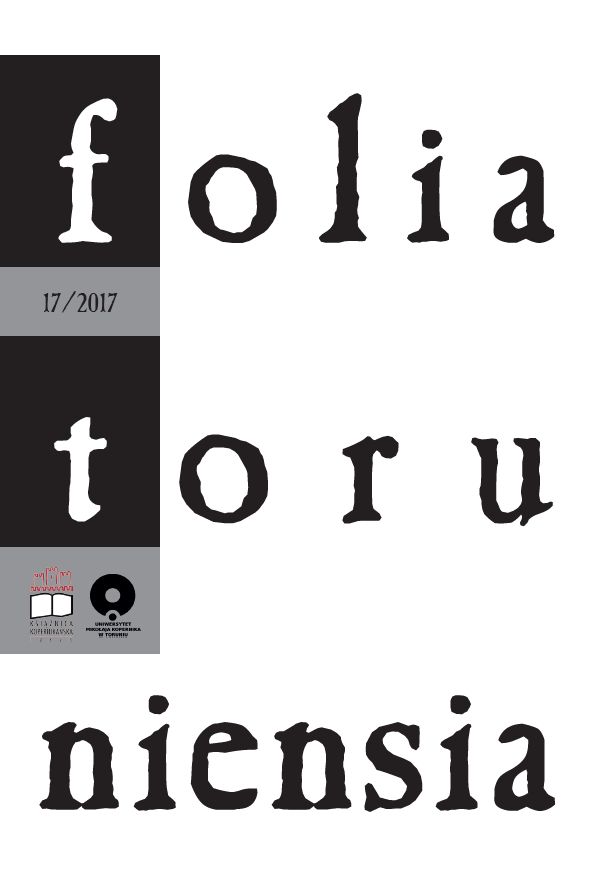The manuscript of the epigram by Philip Melanchton from the collections of the Copernicus Library in Toruń
DOI:
https://doi.org/10.12775/FT.2017.013Keywords
Melanchton, Reformation, the poetry of the 16th century, Academic Gymnasium School in Toruń, Nicolaus Copernicus Public Provincial Library in Toruń, Piotr OsińskiAbstract
The article addresses various issues connected with the manuscript of the epigram De monarchiis by Philip Melanchton and donated in 1607 by Michael Falck (1575–1624) to the gymnasium school library in Torun. The comparative research of the manuscript has proved that it is the original work by Melanchton. The author of the epigram made a substantial number of copies of the poem in the years 1556–1558, which he later gave to his family and friends. They differed in the number of verses: some of them included eight elegiac couplets, while others only seven. The differences between them were not limited only to the number of verses, but they also included varieties of the text in some passages. They were taken into account in the criticism of the edited text, which also included various editions of the epigram. The second part of the article discusses briefly the content of the epigram and its interpretation in the context of the political situation of the epoch when Melanchton lived. The author enclosed the isometric translations of the epigram prepared by Piotr Osiński, the PhD student at the Philological Faculty of Nicolaus Copernicus University in Toruń.References
Barbour, Robert William. 1894. Letters from the Land of Luther. Edinburgh: Edinburgh Press.
Bindseil, Henricus Ernestus, ed. 1856. Corpus Reformatorum. vol. 25, Philippi Melanthonis opera, quae supersunt omnia, post Carolum Gottlieb Bretschneiderum. Halis Saxonum: C.A. Schwetschke et Filium.
Bretschneider, Carolus Gottlieb, ed. 1842. Corpus Reformatorum. vol. 9, Philippi Melanthonis opera, quae supersunt omnia. Halis Saxonum: C.A. Schwetschke et Filium.
Brom, Carolus Friedriech Augustus, Catalogus Bibliothecae Regii Thorunensis. vol. 3 (z lat 1826–1870), KM Rps 121. Rękopisy, Książnica Kopernikańska w Toruniu, Polska.
Curtze, Maximilian. 1875. „Die Handschriften und seltenen alten Drucke der Gymnasialbiliothek zu Thorn“. W Gymnasium mit Realschule I. Ordnung zu Thorn. Zu der am Freitag den 1ten October 1875 stattfindenden öffentlichen Prüfung aller Gymnasial- und Real- Klassen und der Entlassung der Abiturienten ladet ehrerbietigst
und ergebenst ein der Director A. Lehnerdt, 1–40. Thorn: J. Buszczyński.
Epigramma [……] de Monarchiis, KM Rps 108 (R. 2o 22). Rękopisy, Książnica Kopernikańska w Toruniu, Polska.
Goetzius, Georgius Henricus. 1704. Domini Superintendentis Lubecensis, De Joh. Bugenhagii Meritis in Ecclesiam et Scholam Lubecensem Oratio, d. XXVII, Martii Anno MDCCIII in Schola Lubecensi recitata. Lipsiae: Emmerichius.
Himmighöfer, Traudel. 1995. „»De Monarchiis« – ein Melanchthon-Autograph in der Bibliothek der Evangelischen Kirche der Pfalz in Speyer“. W Ebernburg-Hefte 29: (=Blätter für pfälzische Kirchengeschichte und religiöse Volkskunde 62 (1995)) 105–122.
Iaenichius, Petrus. 1723. Notitia bibliothecae Thorunensis. Ienae: Sumtu Ioh. Philippi Haasii.
Jarzębowski, Leonard, zebr. i oprac. 1969. Druki toruńskie XVI wieku. Toruń: Państwowy Instytut Wydawniczy.
Köhler, Manfred. 2013. Melanchthon und der Islam. Ein Beitrag zur Klärung des Verhältnisses zwischen Christentum und Fremdreligionen in der Reformationszeit. Hamburg: Hamburg Severus Verlag.
Mouchel, Christian. 1994. Juste Lipse (1547–1606) en son temps. Actes du colloque de Strasbourg. Genève: Diffusion hors France, Editions Slatkine.
Parchem, Marek, wstęp, przekład i komentarz. 2008. Nowy komentarz biblijny. Stary Testament. Tom 26, Księga Daniela. Częstochowa: Edycja Świętego Pawła, cop.
Praetorius, Ephraim. 1713. Athenae Gedanenses. Lipsiae: apud Jo. Frider. Gleditsch et Filium.
Sammet, Johann Samuel. 1794. In bissecularem memoriam classis supremae et bibliothecae publicae gymnasii Thorunensi nec non typographiae institutae. Thoruni: typis Ioannis Adami Kimmel.
Schubertus, Clemens, conscripti a. 1575. Libri Quattuor De Scrupulis Chronologorum In Quibus Non Solum Calculus Sacrae scripturae cum Serie quattuor Monarchiarum et Olympiadibus Graecorum atque Annis ab Urbe Roma Condita pulcherrima harmonia conciliatur. Argentorati: excusum apud Bernardum Iobinum.
Seebode, Gottfried, hrsg. von. 1824. Neue kritische Bibliothek für das Schulund Unterrichtswesen. Bd. 12 (Sechster Jahrgang, Zweite Band oder Siebenter bis Zwölfter Heft). Hildesheim: In der Gerstenbergschen Buchahandlung.
Sotheby, Samuel Leigh, ed. 1939. Observations Upon the Handwriting of Philip Melanchthon: Illustrated with Fac-similes from His Marginal Annotations, His Common-place Book and His Epistolary Correspondence. Also, a Few Specimens of the Autograph of Martin Luther, with Explanatory Remarks. London: Samuel Leigh Sotheby.
Stupperich, Robert. 1990. „Melanchthon“. W Neue deutsche Biographie. Bd. 16, Maly – Melanchthon, hrsg. von der Historischen Kommission bei der Bayerische Academie der Wissenschaften, 741–745. Berlin: Dunkcer & Humbolt.
Tync, Stanisław. 1949. Dzieje gimnazjum toruńskiego. t. 2. Toruń: Towarzystwo Naukowe.
Zerneke, Jacob Heinrich. 1727. Thornische Chronica in welcher die Geschichte dieser Stadt on 1231 bis 1726 aus bewehrten Scribenten und glaubwürdigen Documentis zusammen getragen worden. Berlin: bey Ambrosius Haude.
Zoepfl, Friedrich. 1998. „Melanchthon“. W Lexikon für Theologie und Kirche. Bd. 7, Maximilian bis Pazzi, hrsg. von Michael Buchberger, Walter Kasper und Konrad Baumgartner kol. 247–249. Freiburg im Breisgau: Herder.
Downloads
Published
How to Cite
Issue
Section
License
Authors sign the license agreement, where authors have copyright but license exclusive rights in their article to the publisher. In this case authors have a range of rights, including:
- The right to share or reuse their article in the same ways permitted to third parties under the Creative Commons Attribution-NoDerivatives 4.0 (CC BY-ND 4.0) license. Following it, the author can "copy and redistribute the material in any medium or format for any purpose, even commercially. The licensor cannot revoke these freedoms as long as you follow the license terms."
- Authors retain patent, trademark and other intellectual property rights (including research data).
- Authors receive proper attribution and credit for the published work.
![]()
Stats
Number of views and downloads: 574
Number of citations: 0



